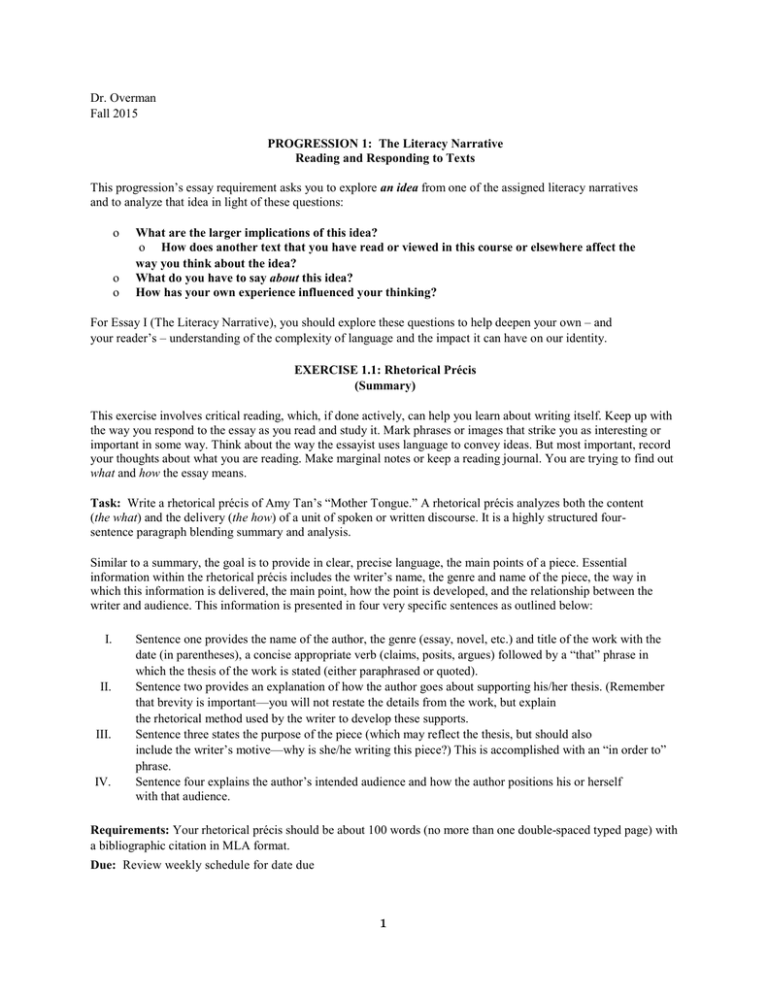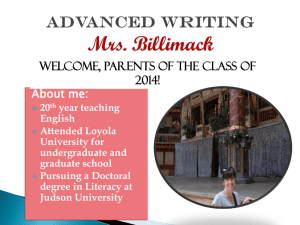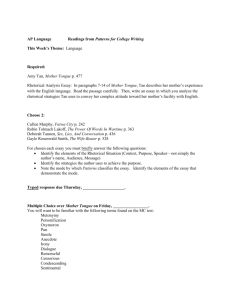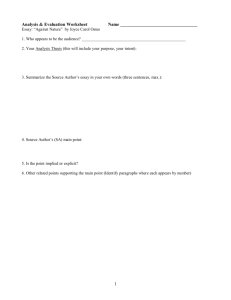Progression 1: Reading and Responding to Texts
advertisement

Dr. Overman Fall 2015 PROGRESSION 1: The Literacy Narrative Reading and Responding to Texts This progression’s essay requirement asks you to explore an idea from one of the assigned literacy narratives and to analyze that idea in light of these questions: o o o What are the larger implications of this idea? o How does another text that you have read or viewed in this course or elsewhere affect the way you think about the idea? What do you have to say about this idea? How has your own experience influenced your thinking? For Essay I (The Literacy Narrative), you should explore these questions to help deepen your own – and your reader’s – understanding of the complexity of language and the impact it can have on our identity. EXERCISE 1.1: Rhetorical Précis (Summary) This exercise involves critical reading, which, if done actively, can help you learn about writing itself. Keep up with the way you respond to the essay as you read and study it. Mark phrases or images that strike you as interesting or important in some way. Think about the way the essayist uses language to convey ideas. But most important, record your thoughts about what you are reading. Make marginal notes or keep a reading journal. You are trying to find out what and how the essay means. Task: Write a rhetorical précis of Amy Tan’s “Mother Tongue.” A rhetorical précis analyzes both the content (the what) and the delivery (the how) of a unit of spoken or written discourse. It is a highly structured foursentence paragraph blending summary and analysis. Similar to a summary, the goal is to provide in clear, precise language, the main points of a piece. Essential information within the rhetorical précis includes the writer’s name, the genre and name of the piece, the way in which this information is delivered, the main point, how the point is developed, and the relationship between the writer and audience. This information is presented in four very specific sentences as outlined below: I. II. III. IV. Sentence one provides the name of the author, the genre (essay, novel, etc.) and title of the work with the date (in parentheses), a concise appropriate verb (claims, posits, argues) followed by a “that” phrase in which the thesis of the work is stated (either paraphrased or quoted). Sentence two provides an explanation of how the author goes about supporting his/her thesis. (Remember that brevity is important—you will not restate the details from the work, but explain the rhetorical method used by the writer to develop these supports. Sentence three states the purpose of the piece (which may reflect the thesis, but should also include the writer’s motive—why is she/he writing this piece?) This is accomplished with an “in order to” phrase. Sentence four explains the author’s intended audience and how the author positions his or herself with that audience. Requirements: Your rhetorical précis should be about 100 words (no more than one double-spaced typed page) with a bibliographic citation in MLA format. Due: Review weekly schedule for date due 1 EXERCISE 1.2: Letter to Author Task: In this assignment, you will explore the part of your identity that is immersed in language. Write a letter to the essayist, Amy Tan, describing the ways in which your experiences with literacy connect with the main ideas in her essay. As a way of generating that letter, reflect upon your own experiences in learning to read and write and how they might resonate with Tan’s experiences. Requirements: Your letter should be 1-2 pages and can be either typed or handwritten. A letter will not usually include either parenthetical documentation or a bibliography. You must make clear in the text of your letter what essay you are writing about and what phrases, images, or ideas you are discussing. Due: Review weekly schedule for date due by the end of class EXERCISE 1.3: Letter to a Friend or Family Member For this writing exercise, select one other essay that you have read during this progression that has something to do with the ideas in Tan’s essay. Task: In a letter to someone not in this class, explain the connection between Tan’s “Mother Tongue” and another essay we have read during this progression. As you compose that letter, think about ways to use evidence to interest your reader in the connection: you might, for instance, tell a story that will ground the idea in a common understanding. Think about what evidence the reader will need to be told so that the connection will make sense. Establish sufficient context for understanding. Requirements: Your letter should be two double-spaced pages long. A letter will not usually include either parenthetical documentation or a bibliography. Consequently, you must make clear in the text of your letter what you are doing, what essays you are writing about, what phrases, images, or ideas you borrowed. The recipient is not expecting this letter and will have no idea why you are writing unless you somehow make it clear. Due: Review weekly schedule for due date on Moodle ESSAY I The Literacy Narrative Our literacy is influenced by family, culture, and education. Sometimes these experiences can work in harmony as they flow into and build on one another. This, however, is not always the case. Sometimes family, culture, and education have different visions and definitions of literacy—visions and definitions which collide and create conflict, tension, or turmoil. Sometimes our experiences with literacy involve both harmony and conflict. Task: Write a literacy narrative that focuses on an aspect of your relationship with reading, writing or education. In this essay, you will explore yourself as a reader and a writer. This exploration will take place in a narrative format, meaning a story with a beginning, middle and end. Narrative can employ techniques such as the use of dialogue and a progression of scenes. Include references to at least two other essays we’ve read during Progression I. Requirements: This essay should be five double-spaced pages (@1500 words) and calls for MLA documentation; you must include a “Works Cited” list at the end of your essay. When you quote key phrases or clauses from the essay, you must provide parenthetical documentation. Due: Review weekly schedule for due dates of each draft (TWO drafts) 2




